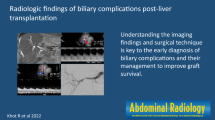Abstract
Although it is recognized that hepatobiliary scan is of value in assessing postoperative complications of biliary surgery or cadaveric whole liver transplantation, there have been few reports regarding its usefulness following living donor liver transplantation. We performed living donor liver transplantation in a patient with biliary cirrhosis due to hepatolithiasis, using a right lobe graft from her sister. On the 15th postoperative day, bile discharge appeared from the operative wound. The leakage point could not be identified by computed tomography and cholangiography from the biliary drainage catheter. Hepatobiliary scan with Tc-99m Sn-N-pyridoxyl-5-methyltryptophan (99mTc-PMT) demonstrated biliary extravasation from the left side of the anastomosis of the hepatico-jejunostomy, indicating biliary leakage from the anastomosis. Conservative therapy was continued because the radioisotope flowed smoothly into the reconstructed jejunum and the biliary drainage catheter, and the leakage was stopped on the 63th postoperative day. Hepatobiliary scan is useful in determining the therapeutic plan as well as detection of bile leakage and identification of leakage points after living donor liver transplatation.
Similar content being viewed by others
References
Kiuchi T, Kasahara M, Uryuhara K, Inomata Y, Uemoto S, Asonuma K, et al. Impact of graft size mismatching on graft prognosis in liver transplantation from living donors.Transplantation 1999; 67: 321–327.
Reding R, de Goyet Jde V, Delbeke I, SoKal E, Jamart J, Janssen M, et al. Pediatric liver transplantation with cadaveric or living related donors: comparative results in 90 elective recipients of primary grafts.J Pediatr 1999; 134: 280–286.
Cronin D, Alonso FM, Piper JB, Newell KA, Bruce DS, Woodle ES, et al. Biliary complication in living related donor liver transplantation.Transplant Proc. 1997; 29: 419–420.
Egawa H, Uemoto S, Inomata Y, Shapiro AM, Asonuma K, Kiuchi T, et al. Biliary complications in pediatric living related liver transplantation.Surgery 1998; 124: 901–910.
Shah AN, Dodson F, Fung J. Role of nuclear medicine in liver transplantation.Semin Nucl Med 1995; 25: 36–48.
Kim JS, Moon DH, Lee SG, Lee YJ, Park KM, Shin JW, et al. Hepatobiliary scintigraphy in the assessment of biliary obstruction after hepatic resection with biliary-enteric anastomosis.Eur J Nucl Med 2000; 27: 170–175.
Kim JS, Moon DH, Lee SG, Lee YJ, Park KM, Hwang S, et al. The usefulness of hepatobiliary scintigraphy in the diagnosis of complications after adult-to-adult living donor liver transplantation.Eur J Nucl Med 2002; 29: 473–479.
Ben-Ami TE, Martich V, Yosefzadeh DK, Whitington PF, Emond JC. Anatomic features of reduced-size liver transplant: postsurgical imaging characteristics.Radiology 1993; 187: 165–170.
Eikman ED. Radionuclide hepatobiliary procedures; When can HIDA help?J Nucl Med 1979; 20: 358–361.
Yen S-H, Liu O-K, Huang M-J. Sequential scintiphotography with technetium-99m pyridoxylidene flutamate in the detection of intrahepatic lithiasis: Concise communication.J Nucl Med 1980; 21: 17–21.
Oshita M, Yasukochi H. Bile leakage after laparoscopic cholecystectomy demonstrated with99mTc-PMT hepatobiliary scintigraphy.Ann Nucl Med 1993; 7: 265–267.
Author information
Authors and Affiliations
Corresponding author
Rights and permissions
About this article
Cite this article
Kanazawa, A., Kubo, S., Tanaka, H. et al. Bile leakage after living donor liver transplantation demonstrated with hepatobiliary scan using99Tc-PMT. Ann Nucl Med 17, 507–509 (2003). https://doi.org/10.1007/BF03006444
Received:
Accepted:
Issue Date:
DOI: https://doi.org/10.1007/BF03006444




